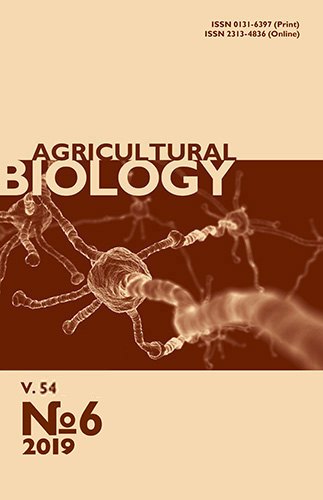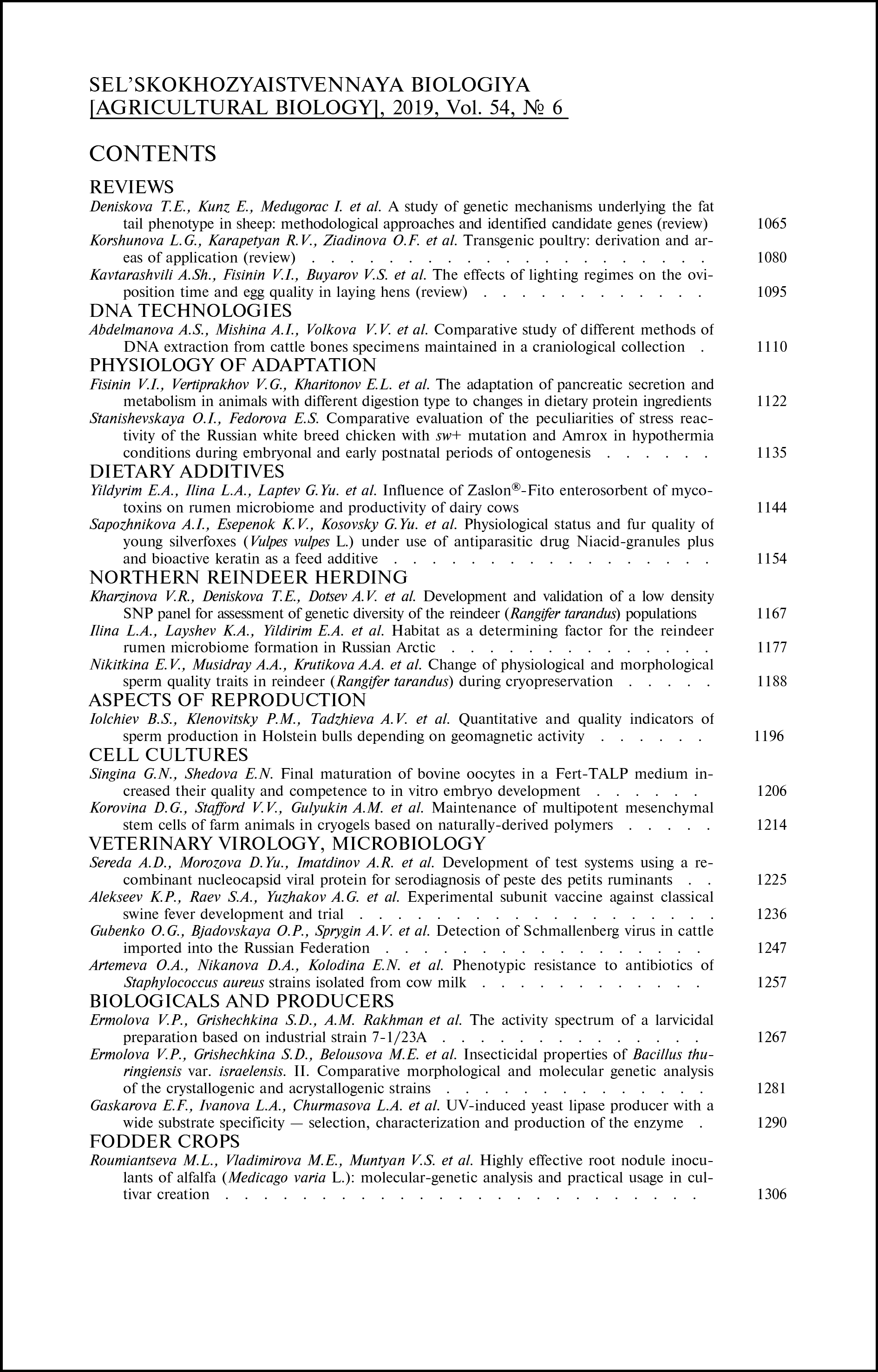doi: 10.15389/agrobiology.2019.6.1144eng
UDC: 636.2:636.085.8:579
Acknowledgements:
Supported financially by Russian Foundation for Basic Research, grant No. 18-016-00207
INFLUENCE OF ZASLON®-FITO ENTEROSORBENT OF MYCOTOXINS ON RUMEN MICROBIOME AND PRODUCTIVITY OF DAIRY COWS
E.A. Yildyrim1, L.A. Ilina1, G.Yu. Laptev1, S.Yu. Zaitsev2
1JSC «Biotrof+», 19 korp. 1, Zagrebskii bulv., St. Petersburg, 192284 Russia, e-mail ilina@biotrof.ru (✉ corresponding author), deniz@biotrof.ru;
2Ernst Federal Science Center for Animal Husbandry, 60, pos. Dubrovitsy, Podolsk District, Moscow Province, 142132 Russia, e-mail s.y.zaitsev@mail.ru
ORCID:
Yildirim E.A. orcid.org/0000-0002-5846-5105
Laptev G.Yu. orcid.org/0000-0002-8795-6659
Ilina L.A. orcid.org/0000-0003-2789-4844
Zaitsev S.Yu. orcid.org/0000-0003-1533-8680
Received June 4, 2019
One of the global problems arising from the extension of opportunistic microflora in canned foods is toxin accumulation. Mycotoxins, the secondary metabolites of micromycetes, suppress immune system, disrupt the functioning of the rumen, intestines, liver, kidneys, reproductive and nervous system of cows, which leads to premature cow disposal. When developing preventive measures to increase the safety level of feed of own procurement, it should be borne in mind that the basis of the modern concept of control pathogens and their toxins is the use of natural environmentally friendly technologies. Modification of sorbents with natural essential oils can help restore the cows’ rumen microbiome disrupted due to the toxins impact. The article presents the results of a study of unidentifiable rumen microorganisms in cattle by T-RFLP (terminal restriction fragment length polymorphism) method. The purpose of the study was to identify the effects of a phytobiotic enterosorbent Zaslon®-Fito on the composition of rumen microbiome, blood biochemical parameters and productivity. Farm test of Zaslon®-Fito enterosorbent was carried out on dairy cows (АО PZ “Plamya”, Leningrad Province, Gatchina District). Two groups of dairy black and white mottled Holstein cows (Bos taurus taurus) of the 2-3rd lactation were formed, 15 animals in each group, for a 71-day experiment. The enterosorbent Zaslon®-Fito was added to the diet by mixing with feed, 20 g per animal per day. At the first step of the investigation, the ELISA method showed that these feeds were contaminated with aflatoxins (9 µg/kg, or 2.4 times higher than the maximum permissible concentration), zearalenone (264 µg/kg, or 2.6 times higher than MPC), and deoxynivalenol (310 µg/kg, MPC = 1000 µg/ml). The use of Zaslon®-Fito had a pronounced positive effect on the milk productivity of cows with a 5.5 % increase in the average daily milk yield per 1 animal (up to 1.8 kg). Analysis of the main biochemical parameters of dairy cows’ blood as influenced by Zaslon®-Fito detected a tendency to total protein level optimization; in the control animals there was a decrease in glucose concentration (to the lower limit), and in the experimental group, we found out an increase in the amount of inorganic phosphorus compared to the control (p ≤ 0.05). The counts of chytridiomycetes (class Neocallimastigales) and archaea in the rumen of cows fed dietary Zaslon®-Fito additive did not change, while the absolute number of bacteria increased to 1.25×1011±5.43×109 genome equivalent per gram. Thus, our investigation shows that Zaslon®-Fito as the dietary additive has a direct positive impact on the animal health and productivity. This is due to multifunctional properties of Zaslon®-Fito, including both high adsorption of mycotoxins and regulation of the rumen microbiota due to some essential oils contained in the composition. The use of enterosorbent Zaslon®-Fito in the diet of dairy cows at the daily rate of 20 g per animal can reduce the risks of the harmful effects of feed mycotoxins and improve the production performance and the quality of the obtained products.
Keywords: unidentifiable rumen bacteria, mycotoxins, enterosorbent, cattle, T-RFLP analysis.
REFERENCES
- Diaz D.E., Hagler W.M. Jr., Blackwelder J.T., Eve J.A., Hopkins B.A, Anderson K.L., Jones F.T., Whitlow L.W. Aflatoxin binders II: reduction of aflatoxin M1 in milk by sequestering agents of cows consuming aflatoxin in feed. Mycopathologia, 2004, 157(2): 233-241 CrossRef
- Driehuis F. Silage and the safety and quality of dairy foods: a review. Agricultural and Food Science, 2013, 22(1): 16-34 CrossRef
- Gallo A., Giuberti G., Frisvad J.C., Bertuzzi T., Nielsen K.F. Review on mycotoxin issues in ruminants: occurrence in forages, effects of mycotoxin ingestion on health status and animal performance and practical strategies to counteract their negative effects. Toxins (Basel), 2015, 7(8): 3057-3111 CrossRef
- Trucksess M.W., Richard J.L., Stoloff L., McDonald J.S., Brumley W.C. Absorption and distribution patterns of aflatoxicol and aflatoxins B1 and M1 in blood and milk of cows given aflatoxin B1. American Journal of Veterinary Research, 1983, 44(9): 1753-1756.
- Kuilman M.E.M., Maas R.F.M., Judah D.J., Gremmels J. Bovine hepatic metabolism of aflatoxin B1. Journal of Agricultural and Food Chemistry, 1998, 46(7): 2707-2713 CrossRef
- Diaz D. Mikotoksiny i mikotoksikozy [Mycotoxins and mycotoxicoses]. Moscow, 2006 (in Russ.).
- Veldman A., Meijst J.A.C., Borggreve G.J., Heeres-van der Tol J.J. Carry-over of aflatoxin from cows’ food to milk. Animal Science, 1992, 55(2): 163-168 CrossRef
- Natour R.M., Yousef S.M. Adsorption efficiency of diatomaceous earth for mycotoxin. Arab Gulf Journal of Scientific Research, 1998, 16(1): 113-127.
- Modirsanei M., Mansoori B., Khosravi A.R., Kiaei M.M., Khazraenia P., Farkhoy M., Masoumi Z. Effect of diatomaceous earth on the performance and blood variables of broiler chicks during experimental aflatoxicosis. Journal of the Science of Food and Agriculture, 2008, 88(4): 626-632 CrossRef
- Simitzis P.E., Deligeorgis S.G. The effects of natural antioxidants dietary supplementation on the properties of farm animal products. In: Animal feed: types, nutrition, safety. Nova Science Publishers, Inc., New York, 2011: 155-168.
- Adil S., Magray S.N. Impact and manipulation of gut microflora in poultry: a review. Journal of Animal and Veterinary Advances, 2012, 11(6): 873-877 CrossRef
- Jang I.S., Ko Y.H., Kang S.Y., Lee C.Y. Effect of a commercial essential oil on growth performance, digestive enzyme activity and intestinal microflora population in broiler chickens. Animal Feed Science and Technology, 2007, 134(3-4): 304-315 CrossRef
- Jamroz D., Wiliczkiewicz A., Wertelecki T., Orda J., Skorupińska J. Use of active substances of plant origin in chicken diets based on maize and locally grown cereals. British Poultry Science, 2005, 46(4): 485-493 CrossRef
- Windisch W., Schedle K., Plitzner C., Kroismayr A. Use of phytogenic products as feed additives for swine and poultry. Journal of Animal Science, 2008, 86(Suppl. 14): E140-E148 CrossRef
- Zeng Z., Zhang S., Wang H., Piao X. Essential oil and aromatic plants as feed additives in non-ruminant nutrition: a review. Journal of Animal Science and Biotechnology, 2015, 6(1): 7 CrossRef
- McIntosh F.M., Williams P., Losa R., Wallace R.J., Beever D.A., Newbold C.J. Effects of essential oils on ruminal microorganisms and their protein metabolism. Applied and Environmental Microbiology, 2003, 69(8): 5011-5014 CrossRef
- Calsamiglia S., Busquet M., Cardozo P.W., Castillejos L., Ferret A. Invited review: Essential oils as modifiers of rumen microbial fermentation. Journal of Dairy Science, 2007, 90(6): 2580-2595 CrossRef
- Maniatis T., Frich E., Sembruk Dzh. Molekulyarnoe klonirovanie [Molecular cloning]. Moscow, 1984 (in Russ.).
- Veterinarno-sanitarnye trebovaniya Tamozhennogo soyuza «O primenenii veterinarno-sanitarnykh mer v tamozhennom soyuze». Utv. resheniem KTS ot 18.06.2010 № 317 [Veterinary and sanitary requirements of the Customs Union «On the application of veterinary and sanitary measures in the customs union» dated 18.06.2010 № 317].
- Polan S.E., Hayes J.R., Campbell T.C. Consumption and fate of aflatoxin B, by lactating cows. Journal of Agricultural and Food Chemistry, 1974, 22(4): 635-638 CrossRef
- Kazartsev V.V., Ratoshnyi A.N., Kazartsev V.V. Zootekhniya, 1986, 3: 323-330 (in Russ.).
- Vasil'eva E.A. Klinicheskaya biokhimiya sel'skokhozyaistvennykh zhivotnykh [Clinical biochemistry of farm animals]. Moscow, 2000: 359 (in Russ.).
- Hungate R.E. The rumen and its microbes. Academic Press, NY, 1966.
- Tarakanov B.V. Metody issledovaniya mikroflory pishchevaritel'nogo trakta sel'skokhozyaistvennykh zhivotnykh i ptitsy [Methods to study microflora of the digestive tract of farm animals and poultry]. Moscow, 2006 (in Russ.).
- Il'ina L.A. Izuchenie mikroflory rubtsa krupnogo rogatogo skota na osnove molekulyarno-biologicheskogo metoda T-RFLP s tsel'yu razrabotki sposobov ee optimizatsii. Kandidatskaya dissertatsiya [The study of cattle rumen microflora based on the molecular biological method T-RFLP with the aim of its optimization. PhD Thesis]. St. Petersburg, 2012 (in Russ).
- Nagaraja T.G., Newbold C.J., Van Nevel C.J., Demeyer D.I. Manipulation of ruminal fermentation. In: The rumen microbial ecosystem. P.N. Hobson, C.S. Stewart (eds.). Springer, Dordrecht, 1997: 523-632 CrossRef
- Krehbiel C.R., Rust S.R., Zhang G., Gilliland S.E. Bacterial direct-fed microbials in ruminant diets: performance response and mode of action. Journal of Animal Science, 2003, 81(14, Suppl. 2): E120-E132 CrossRef
- Elam N.A., Gleghorn J.F., Rivera J.D., Galyean M.L., Defoor P.J., Brashears M.M., Younts-Dahl S.M. Effects of live cultures of Lactobacillus acidophilus (strains NP45 and NP51) and Propionibacterium freudenreichii on performance, carcass, and intestinal characteristics, and Escherichia coli strain O157 shedding of finishing beef steers. Journal of Animal Science, 2003, 81(11): 2686-2698 CrossRef
- Meyer N.F., Erickson G.E., Klopfenstein T.J., Greenquist M.A., Luebbe M.K., Williams P., Engstrom M.A. Effect of essential oils, tylosin, and monensin on finishing steer performance, carcass characteristics, liver abscesses, ruminal fermentation, and digestibility. Journal of Animal Science, 2009, 87(7): 2346-2354 CrossRef
- Cardozo P.W., Calsamiglia S., Ferret A., Kamel C. Screening for the effects of natural plant extracts at different pH on in vitro rumen microbial fermentation of a high-concentrate diet for beef cattle. Journal of Animal Science, 2006, 83(11): 2801-2808 CrossRef
- Guan H., Wittenberg K.M., Ominski K.H., Krause D.O. Efficacy of ionophores in cattle diets for mitigation of enteric methane. Journal of Animal Science, 2006, 84(7): 1896-1906 CrossRef
- Elliott R., Ash A.J., Calderon-Cortes F., Norton B.W., Bauchop T. The influence of anaerobic fungi on rumen volatile fatty acid concentrations in vivo. The Journal of Agricultural Science, 1987, 109(1): 13-17 CrossRef
- Newbold C.J., Wallace R.J., Watt N.D., Richardson A.J. Effect of the novel ionophore tetronasin (IC1 139603) on ruminal microorganisms. Applied and Environmental Microbiology, 1988, 54(2): 544-547.












